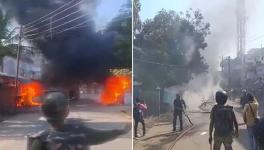Katihar Death: The Never-Ending Saga of Custodial Violence
New Delhi: In August 2019, on the 29th foundation day of the Bureau of Police Research and Development (BPR&D), Home Minster Amit Shah, averred “the era of the third degree is gone. Use forensics to nail the criminals”. In the name of forensic development, the incumbent is covertly bolstering a surveillance state through the Criminal Procedure (Amendment) Act of 2022. Coeval to the statement made in 2019, on September 17, 2022, another custodial death has been reported in Katihar, Bihar. A 40-year-old man was found dead in lock-up following which the villagers went on a rampage and ransacked two police stations leading to a law-and-order situation.
This year, on July 26, the Minister of State for Home Affairs informed the Lok Sabha about custodial deaths and police encounters. According to the statistics, the grim reality of custodial violence surfaced wherein 4,484 custodial deaths were recorded in two years i.e., 2020-2022. Similarly, on March 22, the MoS in the Ministry of Home Affairs apprised the Lok Sabha regarding disciplinary action and prosecution in cases of custodial violence. In 21 cases, disciplinary actions were taken against uniformed personnel. Astonishingly, none were prosecuted, according to the reply.
The appalling statistics of police/judicial custody violence show aggravation in the past decade. This, in turn, raises several relevant queries regarding the promise of ‘right to life and liberty.’ The Indian penal statute under Sections 330 and 348 state the ingredients for custodial violence i.e., causing hurt or confinement for extortion of confession. However, the aforesaid provisions do not define torture or custodial violence.
Along with this, both the provisions are bailable and no particular provision in the penal statute defines custodial death. The provision expressly states that such wilful hurt and confinement shall be to extort confession, which makes prosecution under the provision unlikely. The loosely enacted laws concerning custodial violence or custodial death serve as an impediment to prosecuting the uniformed personnel.
India is a signatory to International Covenant on Civil and Political Rights which via Articles 6 and 7 expressly denounces torture in any form. Also, India is a signatory to the Convention against Torture and Other Cruel, Inhuman or Degrading Treatment or Punishment but has not ratified the convention.
On two accounts, the law regarding custodial violence has surfaced. First, the Prevention of Torture Bill, 2008 died in Parliament because of infirmity and ambiguity in the Bill. The other Bill was a recommendation by the 273rd Law Commission of India in 2017 i.e., the Prevention of Torture Bill, 2017, which was advertently disregarded by the government.
India to date has no chartered definition of torture, custodial violence, or custodial death. However, any definition should be exhaustive wherein custody at any place including police, judicial, juvenile and others should be covered.
Police as an institution was the brainchild of Robert Peel, who, through the Metropolitan Police Act, introduced the London Metropolitan Police. The institution was supposedly instituted to prevent crimes. However, in India, the institution was the handmaiden of the colonial regime to repress all sorts of dissent against imperial rule. India’s freedom fighters were the worst victims of this. The trend has continued even in post-Independence India.
The Police Act of 1861 has been frozen in a time capsule, with no major amendment/s to the principal Act. The institution remains opaque with an anti-minority bias. Several committees have been established for the sake of police reforms in India but the same has not been achieved. Even the slew of recommendations made by the National Police Commission to prevent misuse of the institution arbitrarily remains in black and white.
Several committees that were constituted had recommended police reform. The Law Commission of India had recommended Amendment to the Evidence Act 1872 i.e., Sec. 114B which shall state that ‘…. If there is evidence that the injury was caused during a period when that person was in the custody of the police, the court may presume that the injury was caused by the police officer having custody of that person during that period’. However good and much-needed the recommendations were, they remain on paper.
Indrajit Gupta, the Home Minister of India during 1996-1998, had written a letter to Chief Ministers of all states seeking radical reforms in police institutions. He was vehemently opposed by the existing state of the police institution. He prophesied that if the political executive does not take measures in restructuring the police institution, the judiciary may intervene and force the desirable change down the throats of the political executive.
On several occasions, the Indian judiciary has directed recommendations against violence and torture in custody. Though the wheels of justice grind gradually, the judiciary did set precedents. However, in reality, the stand has been limited to providing pecuniary compensation to the victim's immediate family members. The only amendment concerning the culling of the unprecedented authority of the police by the political executives was the Code of Criminal Procedure Amendment Act of 2008 which inserted Section 41 A-D. The amendment was in tune with the D.K Basu guidelines issued by the apex court after a decade.
In 2020, the apex court in Paramvir Singh Saini vs Baljit Singh, directed all states and Union Territories (UTs) to install CCTV cameras in police stations and the offices of other investigative agencies. However, the status report on the number of CCTVs installed in every state and UTs is a debatable topic and no particular report is in the public domain yet. Along with this, the maladies and lacunae in the legal set-up wherein the elephant in the room is not yet acknowledged, the idea of life and liberty remains obsolete for the greater share of the masses.
It is high time the political executives took a leap and legislate on torture and degrading treatment of prisoners, especially, when India is eyeing a permanent place in the United Nations Security Council.
The writer is a legal practitioner based in New Delhi. Views are personal.
Get the latest reports & analysis with people's perspective on Protests, movements & deep analytical videos, discussions of the current affairs in your Telegram app. Subscribe to NewsClick's Telegram channel & get Real-Time updates on stories, as they get published on our website.
























